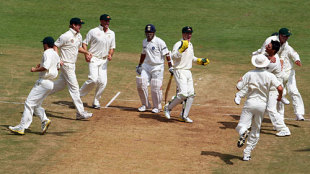|
|
|

Sachin Tendulkar was susceptible to Mitchell Johnson's subtle changes in pace
© Getty Images
|
|
| |
Rahul Dravid has said the strategic field placements Ricky Ponting used were not a surprise - the Australians had adopted a similar "semi-defensive" approach in 2004. If India were expecting a choking strategy, though, they didn't seem to have planned a counter to it and, Dravid apart, the middle-order batsmen were stifled by fielders who cut off their comfort zones.
Sachin Tendulkar seemed to have seen the trap set for him, yet got caught in it. VVS Laxman remained on zero for 11 balls, after his areas of choice were blocked off, and was dismissed off the 12th. Ponting said they had plans for the Indian batsmen but even he might have been surprised at the speed with which they worked.
The Indian openers had scored at a brisk pace on the second evening but, with the bounce getting more unpredictable on the third morning, that passage of play was the exception rather than the norm while the middle order was batting.
Out of the corners of his eyes Sachin Tendulkar could see fielders at short cover, short midwicket and square leg while facing Brett Lee. Against Mitchell Johnson, whose initial plan was to slant the ball across the right-handers to make the batsmen drive, Tendulkar had a packed off side - two slips, a gully, point and short cover. He beat that field twice - once with a glorious cover drive, then with an edgy push which flew wide of gully - but was susceptible to Johnson's subtle changes of pace. The first spooned drive against the slower ball fell tantalizingly short of Cameron White at short cover. A few balls later Tendulkar hit it straight into his hands.
Dravid, Laxman and Mahendra Singh Dhoni found their leg-side options cut off. Two fielders stood a few feet apart at silly mid-on and short midwicket and they were backed up by a conventional mid-on. The close men prevented singles that would result from driving the ball either side of mid-on; the deeper fielder stopped shots which were driven firmly between the two close fielders. There was a man at square leg as well.
"On wickets like this, with the kind of attack they have, we expected them to set fields like that," Dravid said. "Semi-defensive fields with sweepers and more men on the leg side, looking to bowl wicket to wicket. Some days, on wickets like this, it might work. On other days you might have to look at other fields."
But Ponting didn't have to look at other fields for most of today. Laxman fended feebly and nicked Johnson to Haddin, while Dhoni tried to force a straight ball from Michael Clarke and lost his off stump. They were unable to force the Australians into changing their plans and failed to take heed from the vigilant approach which brought Ponting, Michael Hussey and Simon Katich their runs on the second day.
|
|
|

Rahul Dravid: "They [Australia's bowlers] tended to bowl a lot straighter so obviously the tendency is to drift down leg side"
© AFP
|
|
| |
Only Dravid found a method to beat the suffocation. He called upon his ample supply of patience and countered the low bounce by moving decisively on to the front foot. He did not necessarily force Ponting to change his field; instead, he worked around it. Gaps in the infield were hard to pierce so Dravid waited for the ball that was too straight and played it towards long leg, and when it was wide, he scored in the region behind point. Dravid scored 43 out of his 51 runs behind square.
"They [Australia's bowlers] tended to bowl a lot straighter so obviously the tendency is to drift down leg side," Dravid said. "The opportunities to score runs are on that side."
Unlike several of his team-mates, his dismissal was not a result of a rash shot. Dravid later said the pitch was the kind on which "you couldn't trust the bounce" and because of the reverse-swing "you never felt like you were in even if after batting for a long period of time". Moments after reaching his half-century, he was beaten by Shane Watson's inswing and got struck on the pad with the bat extremely close to ball. The decision might have gone his way on another day.
The most refreshing innings of the day, however, came from the carefree bat of Australia's nemesis - Harbhajan Singh. Not shackled by the burden of playing responsible shots - a weight carried by top-order batsmen - Harbhajan opened out in the company of Zaheer Khan. It was not all slogging though for he played several deliveries with caution. However, his determination to hit hard and over the top when he could, forced the Australians to do something they hadn't needed to all day - change their field. It only needed a little spunk.



